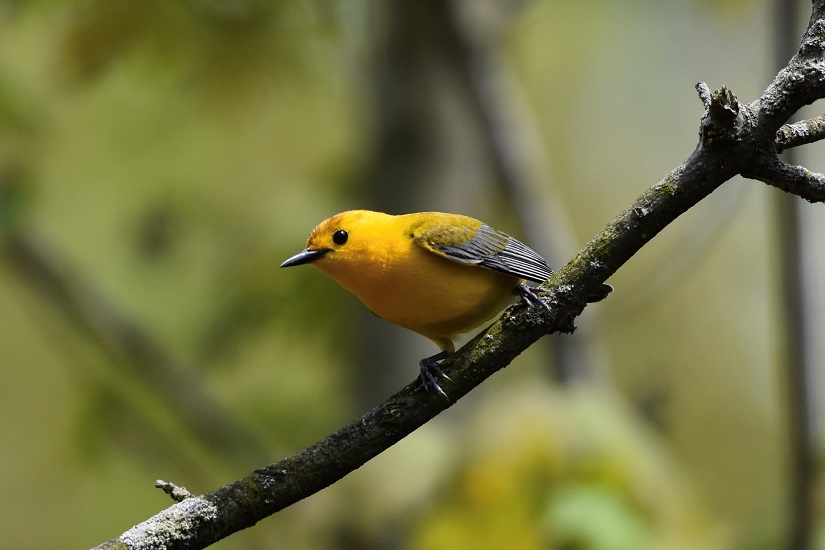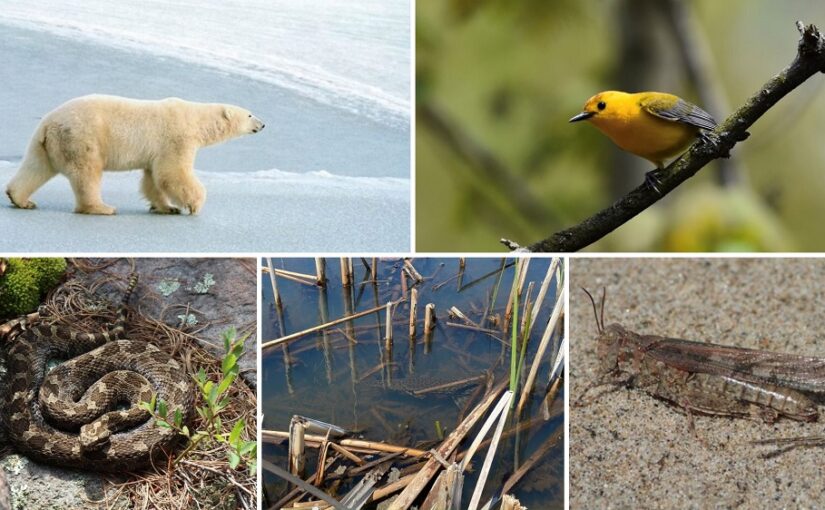Today’s post comes from our Discovery Specialist Dave Sproule.
We are lucky to live in a province where nature has blessed us with many lakes, a variety of landscapes, and an incredible diversity of wildlife.
However, some of the plants and animals that call Ontario home are at risk.
Our provincial parks and conservation reserves play a critical role in protecting these special species.
Stay tuned as we learn all about the at-risk plants and animals found within Ontario Parks, starting with this introduction…
Ontario is a big place
It’s Canada’s second-largest province with much of it north of the 49th parallel.
Our sparsely populated province sees most of us living concentrated in the south, between Lake Ontario, Lake Erie, and Lake Huron/Georgian Bay.
Living in the south can make it difficult to think about the vastness of Ontario.

From north to south — between Polar Bear Provincial Park on the shores of Hudson Bay and James Bay to Rondeau Provincial Park near Ontario’s southern point on Lake Erie — it is 1,400 km in a straight line.
To put that into perspective, travelling that same distance south from Rondeau would take you into central Florida!
This vast size makes us very diverse.

Landscapes, water bodies, and climate all combine to create a huge range of habitats for plants and animals. That huge range of habitats means there are lots of places for plants and animals to live, and lots of diversity in those species.
However, many species are running into challenges, and some are now what we call “species at risk.”
What is a species at risk?
When we think that a species is in trouble, the species is evaluated against different status categories under Ontario’s Endangered Species Act, including:
- extirpated: still living somewhere in the world, and at one time lived in Ontario, but no longer living in the wild in Ontario
- endangered: living in the wild in Ontario, but facing imminent extinction or extirpation
- threatened: living in the wild in Ontario and likely to become endangered if steps are not taken to address factors threatening it
- special concern: living in the wild in Ontario and may become threatened or endangered due to a combination of biological characteristics and identified threats
- not at risk: a species has been assessed and does not quality for any of the above categories
Some species-at-risk are well-known; others are not.
We’ll be showcasing all sorts of species this summer. To start, here’s a little bit about just a few:
Polar Bear
Yes, Ontario Parks protects Polar Bears – the most southerly population in the world!
They’re living on the “southern edge” of their range, which presents challenges.

For instance, the changing climate is a big challenge with respect to their diets. Polar Bears depend on seals for food and must have sea ice to hunt from. The sea ice is now forming later in the year and melting earlier in the year, meaning the bears must go without food for 3 to 4 months!

If the shortened season for sea ice continues, forcing the bears to go without food for an even longer span of time, we may lose our Polar Bears.
Polar Bear Provincial Park, located on the southern shore of Hudson Bay, protects about 70% of Ontario’s maternal denning sites where these bears are born.
Prothonotary Warbler
Along the shores of Lake Erie, the Prothonotary Warbler mirrors the Polar Bear in that this pretty yellow and grey songbird is also at the edge of its range. However, this species occurs and breeds in Rondeau Provincial Park, which is at the northern edge of its range.

In the United States, it is often called the “swamp warbler” because it prefers swamps (wetlands with standing trees) to live in. In the winter, they live in Mexico to South America and migrate north in spring to breed, nesting in tree cavities near wetlands. Habitat loss is the main cause of this warbler’s at-risk status.
Lake Huron Grasshopper
Living in between the northern Polar Bears and southern Prothonatory Warblers is the Lake Huron Grasshopper. This grasshopper is silver-grey to brown in colour with speckles and banding on its front wings that help it to blend in with its sandy habitat.
This rare insect lives exclusively in open dune habitat along the shores of Lake Huron, Lake Michigan, and Lake Superior. Its preferred habitat is the foredune, the low ridge of open, bare sand covered with scattered grasses located closest to the lake.

Sand dunes are actually a rare type of habitat in Ontario. If we combined all of Ontario’s coastal sand dunes together, they would only make up less than 0.5% of the province’s land.
This grasshopper is known to occur at only eight locations in Ontario. One location is Pancake Bay Provincial Park on the southeastern shore of Lake Superior.
The species was once found farther south in Ontario with historic records from Wasaga Beach Provincial Park as well as Giant’s Tomb Island, part of Awenda Provincial Park. The loss of dunes, usually because of development and habitat alterations like footpaths through them to get to beaches, has impacted this insect and led to its at-risk status. (You can help dune species around the province by sticking to official trails and staying off dunes!)
Massasauga Rattlesnake
Its range has been greatly reduced from the days before settlement. Now the islands and rocky shores of eastern Georgian Bay are one of this shy animal’s last havens.
Killbear Provincial Park is at the heart of this Georgian Bay refuge.

Habitat loss is one of the reasons for its disappearance across much of its former range, but road mortality has also been a big factor. Park naturalists at Killbear have been working hard for many years to monitor these reptiles. They’ve also installed snake fences and ecopassages to protect them within the park. Help protect these rare creatures by driving slowly and watching for wildlife.
Fear – based largely on misconceptions – causes many to kill rattlesnakes on sight, which has also contributed to their at risk status. Staff have worked to inform visitors that this little snake is not the danger many believe it to be and needs out help.
Spotted Gar
The Spotted Gar is an ancient fish.
They’ve been around so long that their ancestors were swimming when the dinosaurs roamed the Earth! Sometimes called “primitive fish,” their design hasn’t changed much in 65 million years.
Unlike most fish in Ontario, Spotted Gars have thick, diamond-shaped scales covering their body and part of their scientific name means bony scales.

They can breathe air with the help of their “gas bladder,” which acts as a primitive lung!
Gars are incredible hunters, with the fast movement of such a streamline body, and the rows of very sharp teeth in their long jaws. They sit in ambush waiting for prey, then lunge forwards very quickly. They are usually the top predator in their habitat.
Young gars are hungry! The young eat mosquito larvae – visitors love a mosquito killer!
What can you do to help?
Provincial parks are critical to the survival to many of these species, and we all have a role to play in their protection — including you!
You can:
- be a good park visitor – follow the rules, stick to park trails, and stay off sensitive habitat
- record your sightings of plants and animals – submitting observations through the iNaturalist app helps Ontario Parks staff better protect them
- be a good steward – private landowners can help to protect habitat and species at risk, and support recovery through stewardship programs
- volunteer to help with habitat restoration projects
- donate to help us fund more in-park research and conservation efforts
- make a purchase from our online store (consider our Turtle Protection Project!) — all proceeds are reinvested in park projects
Introducing our species at risk blog series
Join us as we share beautiful, sometimes emotional, uplifting stories of species-at- risk at Ontario Parks.
Travel across the province with our park naturalists to see just how diverse the animal and plant life is in Ontario!
